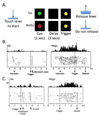From reactive to proactive and selective control: developing a richer model for stopping inappropriate responses
- PMID: 20932513
- PMCID: PMC3039712
- DOI: 10.1016/j.biopsych.2010.07.024
From reactive to proactive and selective control: developing a richer model for stopping inappropriate responses
Abstract
A better understanding of the neural systems underlying impulse control is important for psychiatry. Although most impulses are motivational or emotional rather than motoric per se, it is research into the neural architecture of motor response control that has made the greatest strides. This article reviews recent developments in the cognitive neuroscience of stopping responses. Most research of this kind has focused on reactive control-that is, how subjects stop a response outright when instructed by a signal. It is argued that reactive paradigms are limited as models of control relevant to psychiatry. Instead, a set of paradigms is advocated that begins to model proactive inhibitory control-that is, how a subject prepares to stop an upcoming response tendency. Proactive inhibitory control is generated according to the goals of the subject rather than by an external signal, and it can be selectively targeted at a particular response tendency. This may have wider validity than reactive control as an experimental model for stopping inappropriate responses.
Copyright © 2011 Society of Biological Psychiatry. Published by Elsevier Inc. All rights reserved.
Conflict of interest statement
Financial Disclosure
The author reports no biomedical financial interests or potential conflicts of interest.
Figures






References
Publication types
MeSH terms
Grants and funding
LinkOut - more resources
Full Text Sources

